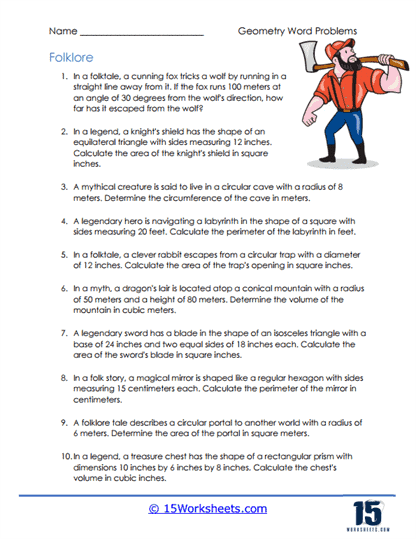Folklore

Worksheet Description
This worksheet presents a collection of geometry word problems set within the context of various folklore tales. The problems incorporate mythical and medieval themes, where students are tasked with applying geometric concepts to calculate distances, areas, perimeters, circumferences, and volumes in stories involving cunning foxes, knight’s shields, mythical creatures, and legendary swords. Each problem is designed to spark imagination while grounding mathematical calculations in intriguing scenarios.
The worksheet is aimed at teaching students to use geometry to solve problems that are framed in a creative and narrative context. It encourages the application of mathematical formulas to calculate the geometry of objects and settings found in folklore, such as calculating the area of an equilateral triangle-shaped shield or the volume of a dragon’s lair located atop a conical mountain. The exercises seek to develop critical thinking and problem-solving skills by translating fantastical situations into practical geometric problems. This approach not only reinforces students’ understanding of geometry but also makes the learning process more engaging by connecting it with storytelling.
Example Problems
1. In a folktale, a cunning fox tricks a wolf by running in a straight line away from it. If the fox runs 100 meters at an angle of 30 degrees from the wolf’s direction, how far has it escaped from the wolf?
2. In a legend, a knight’s shield has the shape of an equilateral triangle with sides measuring 12 inches. Calculate the area of the knight’s shield in square inches.
3. A mythical creature is said to live in a circular cave with a radius of 8 meters. Determine the circumference of the cave in meters.
4. A legendary hero is navigating a labyrinth in the shape of a square with sides measuring 20 feet. Calculate the perimeter of the labyrinth in feet.
5. In a folktale, a clever rabbit escapes from a circular trap with a diameter of 12 inches. Calculate the area of the trap’s opening in square inches.
6. In a myth, a dragon’s lair is located atop a conical mountain with a radius of 50 meters and a height of 80 meters. Determine the volume of the mountain in cubic meters.
7. A legendary sword has a blade in the shape of an isosceles triangle with a base of 24 inches and two equal sides of 18 inches each. Calculate the area of the sword’s blade in square inches.
